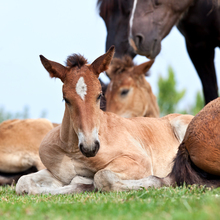Horse owners realize that breeding horses is not what it was 20, even 10 years ago. Now it is nothing to call someone on the other side of the world and through the wonders of artificial insemination (AI), have fresh, cooled or frozen semen or embryos on your doorstep in no time.

The wonders of artificial insemination
A potential downside to the ease of national and global horse breeding is the increased risk of spreading sexually transmitted diseases across state, national and international borders.
Horses, too, are being shuttled from one location to another for breeding purposes. Thoroughbred and Standardbred stallions are regularly shipped to countries below the equator, mainly Australia and New Zealand, to live-cover mares during the North American or European off-season.
However, a potential downside to this ever-improving ease of global breeding is the increased risk of spreading sexually transmitted (venereal) diseases across international borders.
Beyond the immediate health effects of sexually transmitted diseases (STDs) to horses which include abortion, sick or dead foals, discomfort, illness, infertility, is another issue that horse owners should seriously consider: the possible economic implications for not only the owner's particular horses, but the entire equine industry.
It is conceivable that a widespread outbreak of an STD could impact the breeding and equine industry on regional or national levels, even globally. Although the majority of breeders are fully aware of STDs, taking every measure to protect their horses and their interests, ignorance or disregard, could potentially put the industry in peril.
Knowing the facts about STDs such as those described below can go a long way toward understanding the direct as well as far-reaching implications of their spread. Here are some of the sexually transmitted diseases and conditions owners should be aware of and take cautions to prevent:
Contagious Equine Metritis (CEM)
CEM is a highly contagious venereal disease caused by the bacteria Taylorella equigenitalis. Although all breeds can be affected by CEM, Thoroughbreds seem to be more susceptible.
Equine Viral Arteritis (EVA)
EVA, caused by the equine arteritis virus (EAV), can produce respiratory problems and abortions. It occurs in all breeds but Standardbreds and Warmbloods encounter the highest infection rates.
Bacterial Infections
Bacterial organisms such as Pseudomonas aeruginosa and Klebsiella pneumoniae, Streptoccus zooepidemius, Escherichia coli (E-coli) can cause endometritis in the mare. Although present in the horse’s everyday environment, these bacteria can take hold for various reasons, resulting in infection.
One of the prime causes of bacterial infections is believed to be excessive disinfection of the stallion’s penis prior to breeding. Too thorough disinfection removes everyday “good” bacteria allowing opportunistic strains of bacteria to flourish.
Equine Coital Exanthema (ECE)
Equine coital exanthema is a highly contagious viral disease caused by equine herpesvirus 3 (EHV-3). ECE does not cause long-lasting or serious effects such as infertility or abortion, but it can wreak havoc on a breeding season, as horses showing symptoms must not be bred.
Dourine
Dourine is caused by the protozoa Trypanosoma equiperdum. It is only found in Africa, South and Central America, the Middle East and southeastern Europe.
Transmission: Dourine is only spread through breeding and can be transmitted from stallion to mare or vice versa. Incubation ranges from one to four weeks.
Although improved “international” breeding has not resulted in extensive STD outbreaks, the risk is definitely present and horse owners who are using breeding services that cater to an international or even a national clientel should be aware of the risks and make sure that their horses are protected.
Learn more about Preventing Horse Diseases
